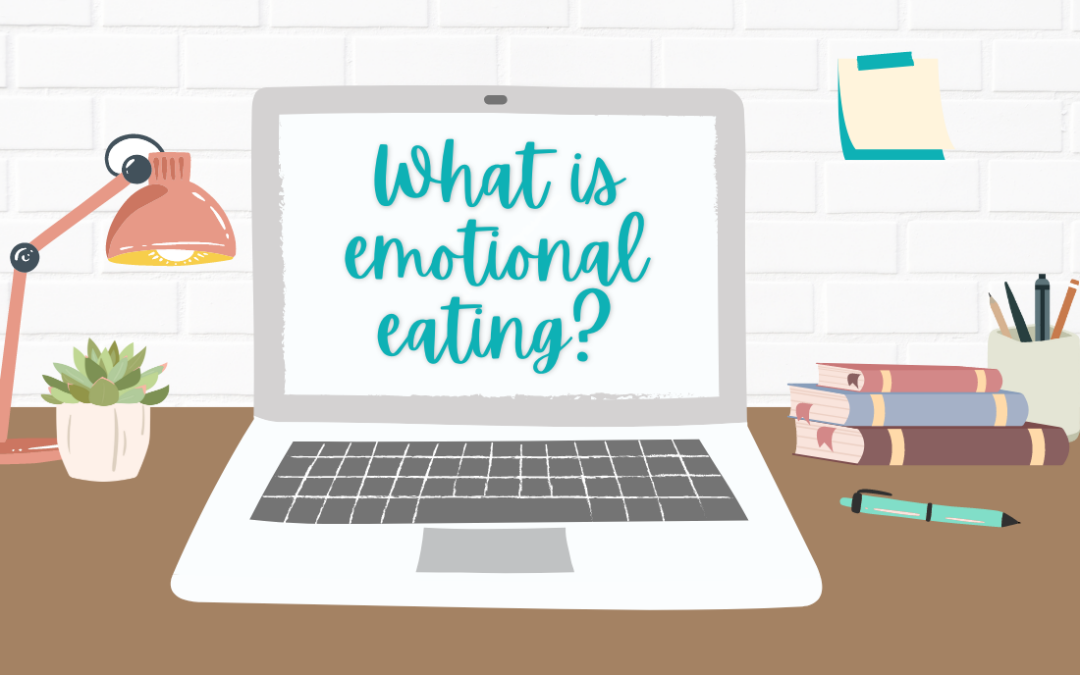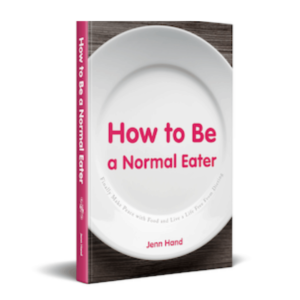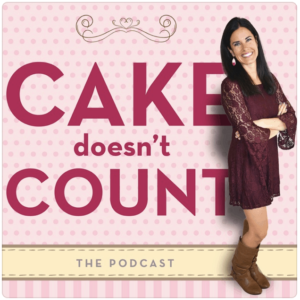For many women who struggle with food, overcoming emotional eating is a key component in overcoming their battle.
Written by Jenn Hand, Holistic Nutritionist, Board Certified Health Coach, NBC-HWC
My Emotional Eating Story
In my own journey, learning how to deal with life without turning to food was one of the hardest but most rewarding parts of my healing.
I used to eat over everything–sadness, boredom, celebration, loneliness, fear, angst…I didn’t even know what I felt many times, as my automatic pattern was to reach for food when I was uncomfortable.
When I first began focusing on feeling my emotions rather than eating over them, I was terrified.
Since it had been decades since I actually felt anything, I was deeply afraid that my emotions would “swallow” me. I was afraid they’d be so intense that I wouldn’t get through them. But as I slowly dipped my toes in the “processing emotions” waters, I realized that while feeling feelings wasn’t always a walk in the park, it did begin to pay off in normalizing some of my eating.
Fear can be a big part of the process in overcoming emotional eating.
We may be afraid of emotions or fear what a specific feeling actually feels like. I always recommend that we start small in the world of emotions. Being willing to experiment just a bit around feelings can build confidence that we CAN get through a hard emotion or uncomfortable situation.
Key Takeaways:
- Emotional eating is eating food in response to emotions, not physical hunger, and using food as a coping mechanism.
- Emotional eating may lead to weight fluctuations and emotional issues, creating a negative feedback loop.
- It is often rooted in personal history, childhood habits, and stress from relationships, financial pressures, and societal influences.
- You can tell that you’re eating emotionally if you’re craving comfort food and eating when stressed.
- The emotional eating cycle starts with a trigger that leads to comfort eating, guilt, and further emotional eating. It’s a vicious cycle!
- Physical hunger develops gradually and has physical signals, while emotional hunger is sudden, linked to cravings, and emotionally driven.
- Intuitive eating encourages tuning into hunger signals, reducing reliance on food for comfort, and cultivating a balanced relationship with food.
Table of Contents
- What Is Emotional Eating?
- What Is the Impact of Emotional Eating?
- What Causes Emotional Eating?
- How Certain Eating Habits May Inform Emotional Eating
- The Emotional Eating Cycle
- How to Understand the Difference Between Physical and Emotional Hunger
- How Intuitive Eating Can Help Prevent Emotional Eating Over Time
- 4 Essential Strategies to Overcome Emotional Eating
- Why I Don’t Talk about “Eating Disorders” When Discussing Emotional Eating
- Do I need help from a mental health professional or can I work with a food relationship coach or other health coach?
- Common Questions about Emotional Eating
What Is Emotional Eating?
Emotional eating refers to the practice of eating in response to feelings rather than physical hunger.
It involves using food as a coping mechanism for dealing with emotions like stress, sadness, boredom, loneliness, or even happiness.
Unlike eating to satisfy physiological needs, emotional eating is driven by the need for comfort, distraction, or emotional relief. This behavior can become habitual and lead to the being stuck in the binge and restrict cycle, where emotional triggers consistently lead to overeating.
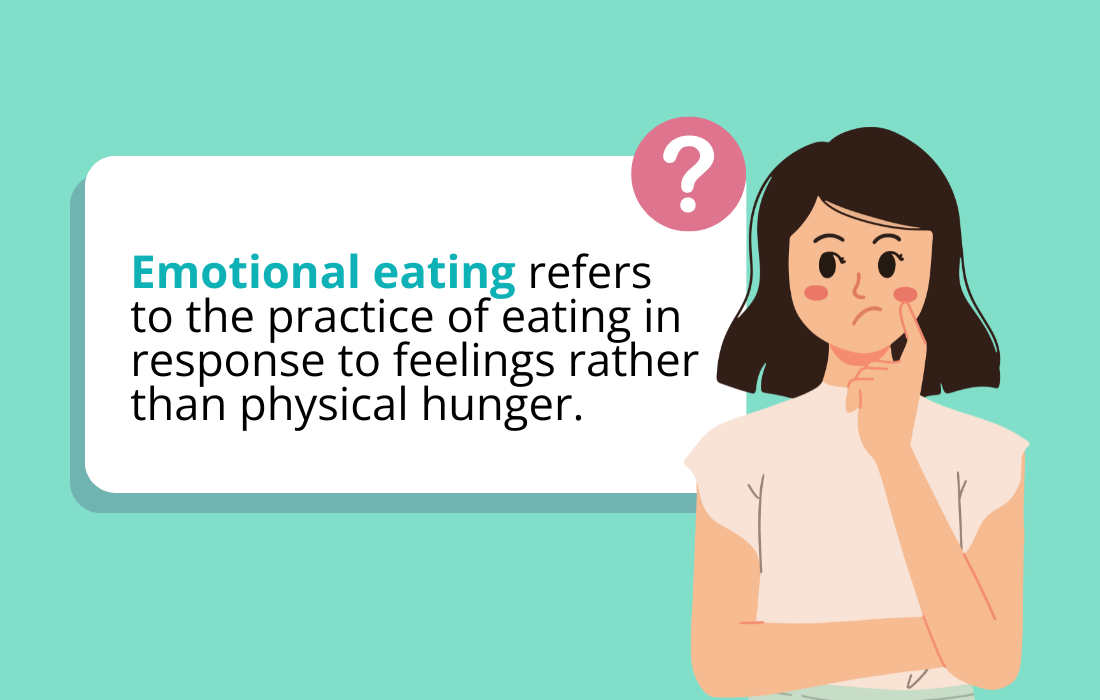
What Is the Impact of Emotional Eating?
The impact of emotional eating can be significant and multifaceted.
Physically, it can lead to being caught in the binge and restrict cycle. This can cause weight gain/weight loss cycles that feel challenging (or impossible) to escape. Emotionally, it can perpetuate a cycle of guilt, shame, and dissatisfaction with our bodies and how we see ourselves.
This negative feedback loop often exacerbates the original emotional triggers, creating a vicious cycle.
Additionally, emotional eating can interfere with our ability to develop healthy coping mechanisms, as reliance on food for comfort can overshadow other, more effective strategies for managing emotions.
Often times, we also blame ourselves–which then adds to the pressure we put on ourselves to “fix” a problem we actually may not know how to fix.
We think it’s a “simple” solution: just stop eating. But in reality, learning to feel feelings can be challenging if we didn’t learn what to do with emotions growing up. The blame and shame we carry can cause us to be stuck in a negative and critical view of ourselves and our bodies.
What Causes Emotional Eating?
The causes of emotional eating are varied and can be deeply rooted in our personal history, how we grew up, and our emotional experiences.
Common triggers, like stress from work, relationships, or financial pressures, can prompt the need for quick comfort. Emotional eating can also stem from childhood habits, such as being rewarded with sweets or using food to soothe distress.
Societal pressures and media portrayals of ideal body images can lead to emotional distress and subsequent overeating. Psychological factors, such as low self-esteem, depression, or anxiety, often play a crucial role in the development of emotional eating patterns.
Typically, those who struggle with emotional eating, don’t learn how to deal with emotions growing up.
Whether it’s for survival, to deal with trauma, or for some other reason, we grow up using food as a way to get comfort, love, safety and many other emotions. This childhood pattern that we learn can stay with us well into adulthood until we learn how to deal with feelings rather than habitually turn to food, like we learned growing up.
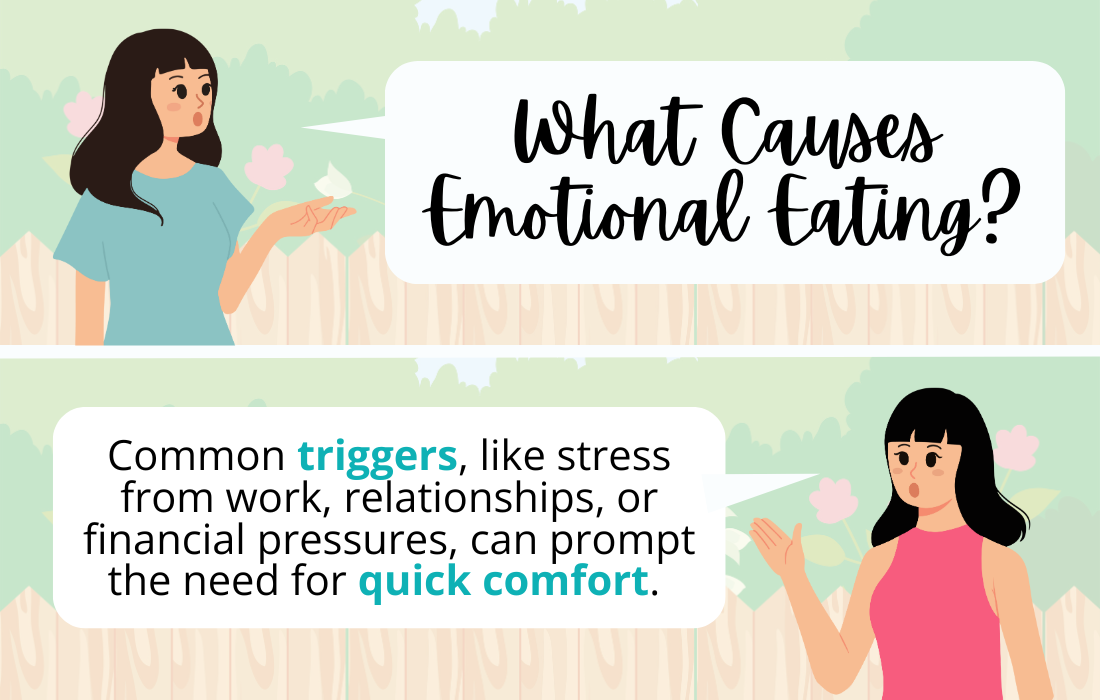
How Certain Eating Habits May Inform Emotional Eating
Certain eating habits can serve as indicators of emotional eating.
For instance, eating in response to specific emotions rather than hunger signals suggests a reliance on food for emotional regulation. Frequent cravings for high-calorie, sugary, or fatty foods, especially during times of stress or emotional upheaval, can also be a sign.
Additionally, mindless eating—where one consumes food while distracted or without paying attention to hunger cues—can indicate emotional eating tendencies. Recognizing these habits is helpful in identifying and addressing the underlying emotional needs that drive them.
You may also notice you turn to food if you are uncomfortable. This was a big one for me.
I realized whenever I felt the slightest discomfort–whether it was social anxiety, fear of being intimate with a boyfriend, sadness over a friendship drifting apart, overwhelmed with work tasks, uncertainty over career or what I wanted to “do” with my life–I would immediately turn to food. Wanting to avoid discomfort is one of the biggest reasons we can eat.
The Emotional Eating Cycle
The emotional eating cycle is a pattern many of us find ourselves trapped in, often without even realizing it.
It typically begins with an emotional trigger—maybe a stressful day at work, an argument with our partner or feelings of loneliness or sadness. In these moments of emotional intensity, we may find ourselves reaching for comfort foods, those high-calorie, sugary, or fatty snacks that seem to offer solace.
The act of eating these comfort foods provides temporary relief or pleasure, a brief escape from the emotional discomfort.
However, this relief is fleeting and often replaced by a surge of negative emotions. Feelings of guilt, shame, or regret may set in, as we criticize ourselves for eating “unhealthily” or for consuming more than we intended. These feelings can be overwhelming, compounding the initial emotional distress that triggered the eating in the first place.
Those negative emotions can then lead us back to the very behavior we were trying to escape–seeking out more comfort foods to soothe our feelings. The cycle continues, creating a vicious loop of emotional eating and self-criticism.
Breaking this cycle requires a conscious effort to become aware of our emotional triggers and our responses to them.
Practicing mindfulness can help us recognize when we are eating out of emotional need rather than physical hunger. By taking a moment to pause and reflect on our feelings, we can identify the root emotions driving our cravings and explore healthier ways to address them. This might involve developing new coping mechanisms, such as physical activity, engaging in a hobby, or seeking support from friends, family, or a therapist.
By shifting our focus from using food as an emotional crutch to finding more constructive ways to manage our emotions, we can gradually dismantle the emotional eating cycle and build a healthier, more balanced relationship with food.
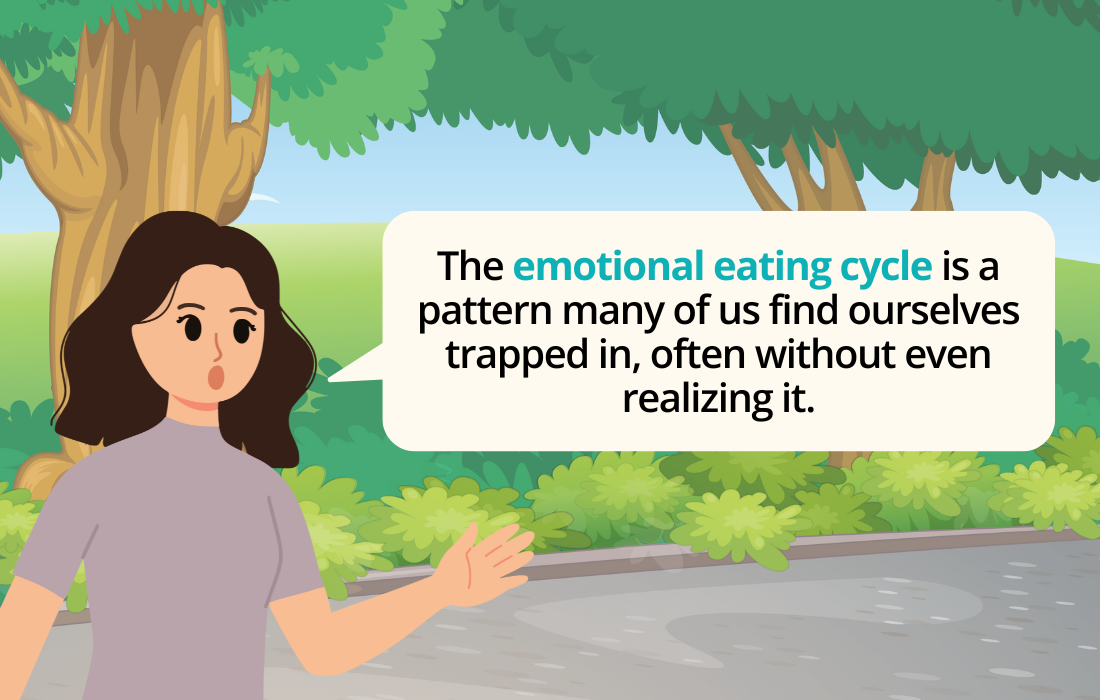
How to Understand the Difference Between Physical and Emotional Hunger
Understanding the difference between physical and emotional hunger is important for managing emotional eating.
Physical hunger develops gradually and is accompanied by physiological signals such as stomach growling, low energy, or lightheadedness. It can be satisfied with a variety of foods and leads to a sense of satisfaction once adequately nourished.
Emotional hunger, on the other hand, arises suddenly and is often linked to specific cravings for comfort foods. It can be driven by a person, a situation, a comment, or some specific experience that triggers an intense emotion. It is not satisfied by eating and can lead to feelings of guilt or shame.
Learning to distinguish between these types of hunger involves tuning into one’s body and emotions, and practicing mindful eating to ensure that food choices are driven by genuine physical needs rather than emotional impulses.
How Intuitive Eating Can Help Prevent Emotional Eating Over Time
Intuitive eating can be a powerful tool in preventing emotional eating by helping us develop a healthy relationship with food and body.
This approach encourages individuals to tune into their body’s natural hunger and satiety signals, rather than external cues or emotional triggers. By practicing intuitive eating, people learn to recognize and respond to their physical hunger, distinguishing it from emotional hunger.
This mindful awareness reduces the likelihood of using food as an emotional crutch. Intuitive eating promotes self-compassion and body positivity, helping individuals to move away from restrictive diets and the negative emotions they often trigger. Over time, this creates a sustainable and balanced approach to eating that honors both physical and emotional needs without resorting to emotional eating.
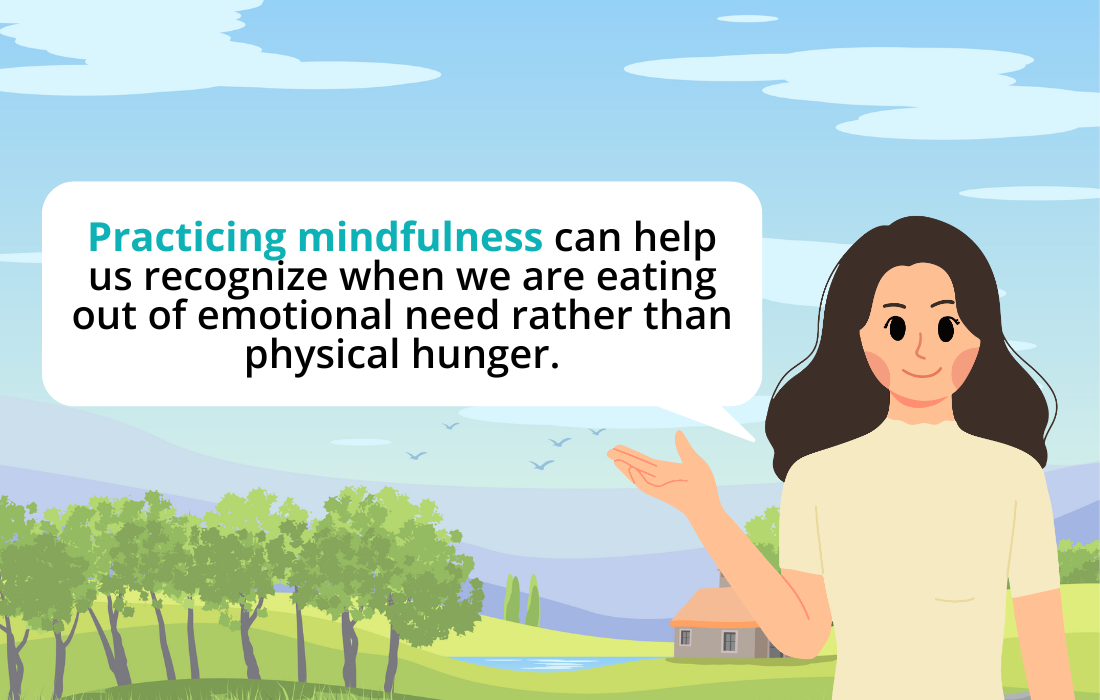
4 Essential Strategies to Overcome Emotional Eating
1) Make sure to keep your blood sugar balanced
This may not sound like it’s related to emotions directly, but it’s actually the key step in being able to overcoming binge eating (which can often be linked to emotional eating.)
I typically recommend eating every 3-4 hours, adding protein every time you eat. This begins to develop consistency in your body’s rhythms and helps you to feel more balanced throughout the day.
When you have consistent meal and snack times, your body learns to expect nourishment at specific intervals, which helps regulate hunger and reduces the likelihood of binge eating.
When we’re feeling balanced, we’re able to make more conscious, rational choices around food.
If an intense emotions hits, it’s “easier” to face it and process it when our blood sugar isn’t low. Skipping meals or going too long without eating can lead to the “hangry” feeling–making it harder to distinguish between physical hunger and emotional cravings.
By eating balanced meals at regular intervals, you can maintain stable blood sugar levels, which helps prevent mood swings and allows you to be more sane when it comes to dealing with emotions.
Eating every 3-4 hours ish also helps you to be more rational and conscious when you’re making food choices.
Planning your meals and snacks ahead of time allows you to focus on satisfaction and nourishment. It doesn’t mean you have to be rigid in your planning (like a diet) but that you gently plan your day according to the meals and snacks you’ll need. This prevents a blood sugar crash–which always leaves us ravenous and choosing the easiest, quickest food in sights (usually sugar or starchy carbs because they are the quickest burst of energy.)
Over time, this structured approach to eating can help you build a more intuitive relationship with food, where you are better able to respond to your body’s genuine hunger signals rather than emotional urges.
2) Identify and address your triggers
Family can be big triggers for most people.
There’s always that one person’s comments or appearance or demeanor that may trigger you. It’s important to take a look at who or what sends you to the food. When I began looking at my own triggers, I realized my sister and her weight loss cycles were a big trigger for me. When she sold Herbalife, she would have these weight loss swings that would always rile me up inside.
If I went to visit family and she had lost weight, I would immediately question my own (long and slower) journey.
Should I just drink shakes to lose weight? Was I really going to try to not diet if I wanted to be thinner? Should I just throw in the towel and say screw it? People would comment on her weight loss and I’d spiral into self-doubt and insecurity in my own body. But what was really helpful for me was identifying that this was a trigger and planning for it.
When I’d visit family, I created a plan to help me get through those triggers.
I always made sure I took a walk or got a few minutes to myself each day and was more mindful of how often I ate to keep me balanced. If I did get triggered, I’d take a breather outside until I was alone with my journal to be able to process and release whatever emotions bubbled up. (I would sometimes even journal sitting on the toilet before a shower, as it was the only time I’d be alone!)
Having a plan and some options helped me move through any triggers that came up during family visits.
Keeping a food diary can be an effective way to highlight what your sticking points are and where you are emotionally eating. This can help you spot patterns and understand the underlying causes of the times you turn to food. Once you have identified your triggers, you can begin to develop healthier ways to cope with those emotions. Or even come up with a plan for specific situations that you know may bring up intense emotions.
What would help you get through these triggers? What is it that you need? It may be journaling or walking.
It could be stealing a few minutes alone. Maybe it’s having a friend to call in hard emotional times to express how you feel. See if you can identify who or what triggers you and then come up with a few options that will help you move through it.
I used to have a very small inspirational book that I kept in my purse that I would go to the bathroom and read through when I needed a little boost.
This would help me reconnect to myself and feel grounded so I could face the person or situation that triggered me. No plan is too “weird!” I’ve had teacher clients hide under their desks to steal a few minutes to eat lunch while the kids were at recess, doctor clients sneak into a supply closet to do a few yoga poses to re-center, and other clients who would go MIA at parties for a bit to breathe through an intense emotion.
3) Develop other ways to get your emotional needs met
One of the reasons we turn to food is because we typically don’t know how to deal with whatever feeling we are facing.
We didn’t grow up learning how to move through sadness, anxiety, fear, uncertainty or any other challenging emotion we feel as human beings.
A part of letting go of emotional eating is exploring how to get our needs met in other ways.
What else brings you comfort? What else supports you through sadness? How can you allow yourself to process loneliness? These are all questions to reflect on and journal about–to explore your own emotional landscape to see what you feel and what you really need when you have that emotion.
Developing ways to get your needs met and exploring other coping mechanisms is key to managing emotional eating.
This involves finding alternative ways to deal with stress, anxiety, and other emotions that do not involve food. Maybe it’s journaling, walking, breath work or physical movement. It could be a good cry, art therapy, tapping (EFT), or spending time in nature. Explore ways to process, express and move through your emotions.
Exploring emotions isn’t only “processing.” It can also be about taking action and finding alternative activities that provide comfort and relief.
If stress is a major trigger for you, maybe you explore stress-reducing practices such as yoga, meditation, or deep breathing exercises into your routine. If loneliness or boredom is driving your emotional eating, maybe you play around with social activities or picking up a new hobby that keeps you engaged and fulfilled.
By addressing the root causes of your emotional eating, you can reduce the frequency and intensity of cravings and develop more sustainable and healthy coping mechanisms.
Another aspect of developing healthy coping mechanisms is engaging in activities that bring you joy and fulfillment.
Creative pursuits like painting, writing, or playing music can be therapeutic and help you express emotions in a constructive way. Similarly, practicing relaxation techniques such as deep breathing, progressive muscle relaxation, or mindfulness meditation can help you manage stress and anxiety.
By incorporating these activities into your daily routine, you can build a toolkit of healthy coping strategies that support your emotional well-being and reduce reliance on food for emotional comfort.
4) Practice slowing down and getting curious
Mindful eating with an attitude of curiosity is a powerful strategy to overcome emotional eating.
This practice involves paying full attention to the eating experience, from the moment you choose your food to the last bite, and cultivating a curiosity about your eating patterns.
By being fully present, you can better recognize when you are truly hungry and when you are eating for emotional reasons. Start by slowing down your eating process: chew your food thoroughly, savor each bite, and focus on the textures, flavors, and aromas.
Pay attention to what arises without judgement. Be open and curious about what you find.
This not only enhances your enjoyment of the food but also helps you tune into your body’s signals of hunger and fullness, making it easier to stop eating when you are satisfied. Incorporating mindful eating into your daily routine can also help break the automatic response of reaching for food in response to emotional triggers.
When you find yourself craving something outside of meal times, take a moment to pause and ask yourself if you are physically hungry or if something else might be driving the urge.
Approach this with a sense of curiosity—notice patterns in your eating habits and what emotions or situations tend to trigger your cravings. If it’s emotional hunger, explore other ways to address your emotions, such as taking a walk, practicing deep breathing, or engaging in a hobby.
Over time, mindful eating can shift your focus from using food as a coping mechanism to appreciating it as nourishment for your body.
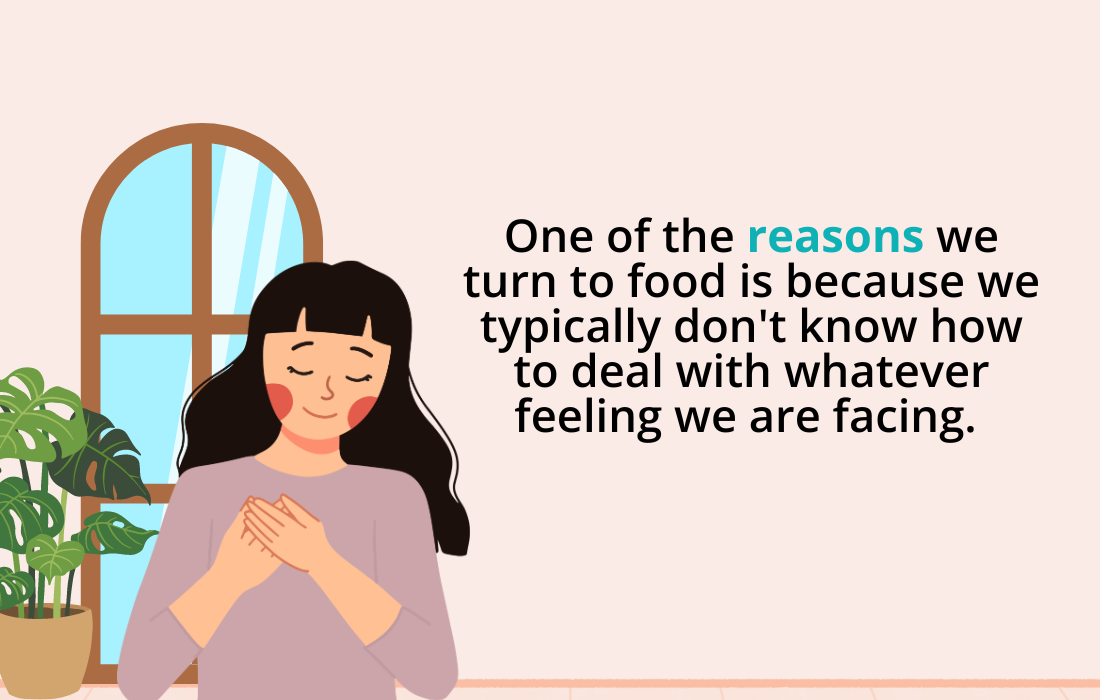
Why I Don’t Talk about “Eating Disorders” When Discussing Emotional Eating
I don’t talk about “eating disorders” or “disordered eating” when discussing emotional eating because emotional eating, while problematic, does not necessarily fit the clinical criteria of an eating disorder.
Emotional eating is often a coping mechanism for managing stress and other challenging emotions rather than a diagnosable condition like anorexia, bulimia, or binge eating disorder.
While emotional eating can lead to bingeing and potentially contribute to more severe eating issues, it is important to address it in a context that focuses on improving emotional coping strategies and developing a healthier relationship with food.
By distinguishing emotional eating from clinical eating disorders, it allows the focus to be on learning how to process feelings and face life without turning to food.
Do I need help from a mental health professional or can I work with a food relationship coach or other health coach?
A food relationship coach or health coach can provide valuable support and strategies for managing and overcoming emotional eating.
It depends on the person’s background as to whether you may need help from a mental health professional. Seeking the appropriate support can be helpful. And finding someone you connect with and who understands your experience is key!
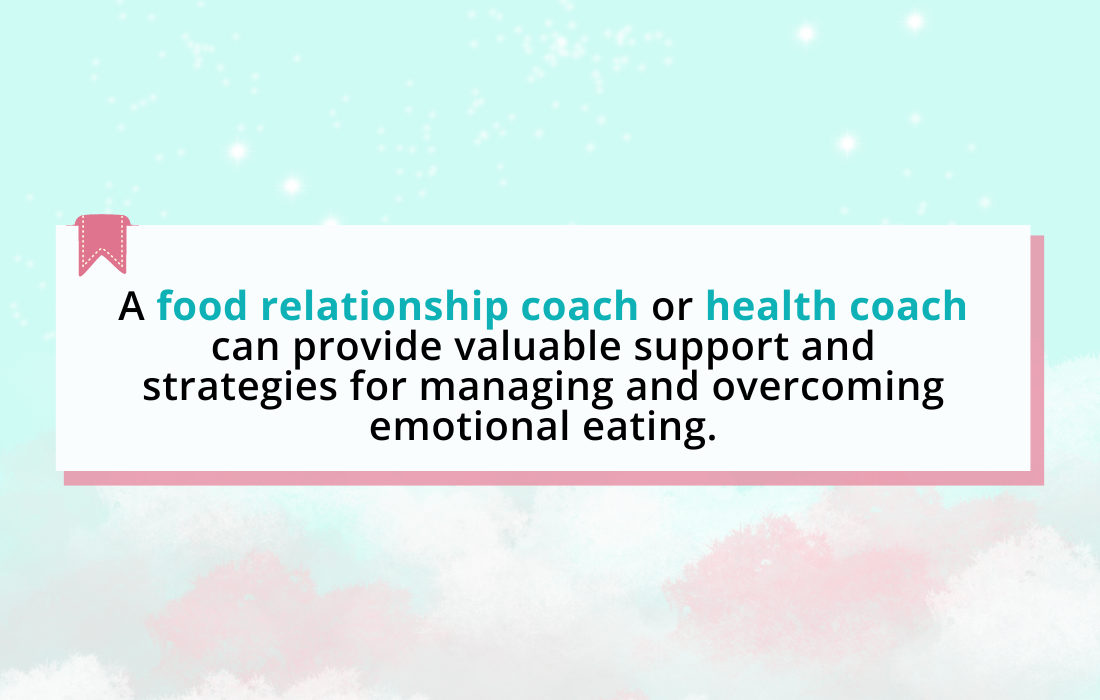
Common Questions about Emotional Eating
What is emotional hunger?
Emotional hunger is the urge to eat in response to emotions rather than physical hunger.
It often involves cravings for specific comfort foods and arises suddenly, usually driven by feelings like stress, sadness, or boredom.
How can I know if I’m an emotional eater?
You might be an emotional eater if you find yourself eating in response to emotions rather than hunger and often crave specific comfort foods during emotional highs and lows.
Keeping a food diary and noting your emotional state when you eat can help identify patterns of emotional eating.
What is the biggest myth about emotional eating?
The biggest myth about emotional eating is that it is solely a lack of willpower.
In reality, emotional eating is often a complex coping mechanism for managing difficult emotions and stress.
Is emotional eating an eating disorder?
Emotional eating is not classified as a specific eating disorder, but it can be a symptom of other eating disorders or lead to unhealthy eating patterns.
It is important to address emotional eating to prevent potential health issues and improve overall well-being.
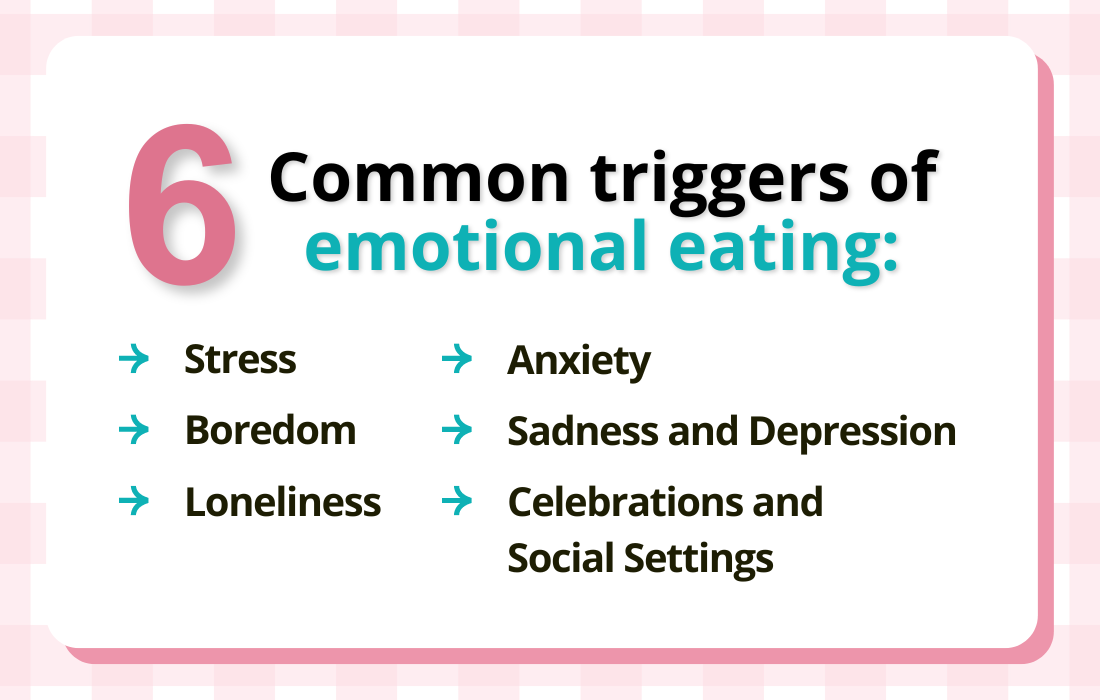
Why is emotional eating harmful?
Emotional eating can be challenging because we usually blame ourselves for not being able to “fix” the problem.
We think it’s a simple problem and we should be able to solve it ourselves–so we often feel blame and shame ourselves leading to internal feelings of self-criticism and angst.
Is emotional eating related to binge eating disorder?
Yes, emotional eating can be related to binge eating disorder, as both involve eating large quantities of food in response to emotional triggers.
However, binge eating disorder is a more severe condition and can often require deeper support. Not all emotional eaters binge.
What is mindful eating and does it help with emotional eating?
Mindful eating involves paying full attention to the eating experience, savoring each bite, and being aware of hunger and fullness cues.
It helps with emotional eating by encouraging a healthier relationship with food and reducing the reliance on food for emotional comfort.
How does physical hunger feel different from emotional hunger?
Physical hunger develops gradually and is accompanied by physiological signals such as a growling stomach or low energy.
Emotional hunger arises suddenly, is often linked to specific cravings, and is driven by emotional needs rather than the body’s need for nourishment.
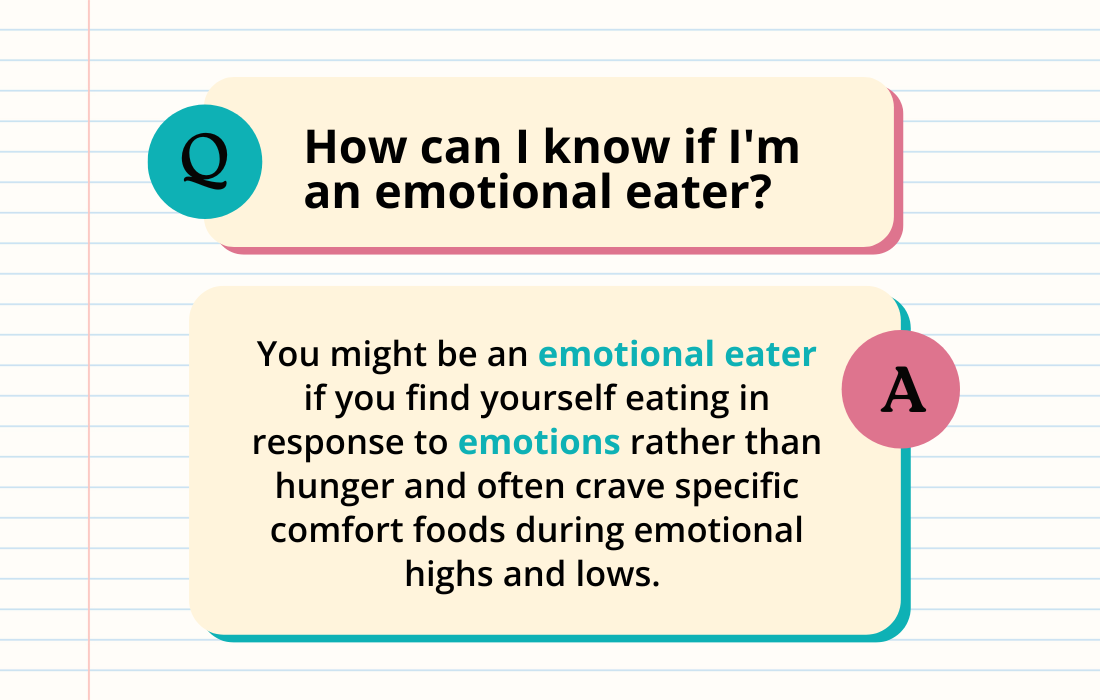
What is stress eating?
Stress eating is when you turn to food as a way to cope with negative emotions like stress, anxiety, or frustration.
Rather than eating because you’re physically hungry, stress eating is a response to emotional discomfort.
It’s about seeking comfort, distraction, or relief through food. Often, the foods chosen during stress eating are high in sugar, fat, or salt, providing a temporary sense of pleasure or escape. However, this can lead to a cycle of guilt and further stress, as your underlying emotional issues are still there and haven’t been addressed.
Recognizing that you’re eating because you’re stressed involves being mindful of your eating triggers and patterns, and finding healthier ways to manage stress, such as through exercise, meditation, or talking to a friend. By understanding the root cause of your stress eating, you can begin to break the cycle and develop a more balanced relationship with food.
What is the difference between emotional and physical hunger?
Understanding the difference between emotional and physical hunger is key!
Physical hunger is your body’s natural cue that it needs nourishment. It develops gradually and can be satisfied with a variety of foods. It is accompanied by physical feelings like a growling stomach or low energy. Once you eat, physical hunger goes away.
In contrast, emotional hunger comes on suddenly and is tied to feelings rather than a physical need. It often craves specific comfort foods and persists despite having a full stomach.
Emotional hunger might be triggered by stress, boredom, loneliness, or other emotions and is not satisfied by eating, leading to feelings of guilt or shame afterward.
To distinguish between the two, take a moment to check in with your body and emotions before eating.
Ask yourself if you’re physically hungry or if there’s an emotional need that could be met in another way. Emotional hunger is a cue that you need to nourish yourself on some level.
What are some common food cravings that indicate emotional hunger?
Emotional hunger often manifests through specific food cravings that provide comfort or a quick mood boost.
Common cravings include sugary, salty, high-carb, and high-fat foods as well as caffeinated beverages. Recognizing these cravings as signals of emotional hunger rather than physical need is the first step toward addressing the underlying emotions without relying on food for comfort.
That’s not to say that a salt craving is always emotional. But check in to see if what you’re craving is emotional or physical.
What kinds of things trigger emotional eating?
Emotional eating can be triggered by a variety of emotional states and life situations.
Common triggers include:
- Stress
- Boredom
- Loneliness
- Sadness and Depression
- Anxiety
- Celebrations and Social Settings
Related Articles
⚪ Intuitive Eating Coach: How Food Coaching for Normal Eating Works & Is It Right For You?
⚪ Why We Struggle with Intuitive Eating (And Tips To Help!)
⚪ Are You Afraid You’re Doing Intuitive Eating Wrong?
⚪ Intuitive Eating for Weight Loss Tips to Get You Started
Get the Normal Eater’s Newsletter
Join 8000+ women who are overcoming overeating, binge eating, and breaking up with dieting forever. Get Jenn’s inspiring and actionable weekly newsletter with the latest posts, podcasts, and tips on how to love your body, find food freedom, and lose weight holistically.
Get the Normal Eater’s NewsletterWork with an Emotional Eating & Holistic Nutrition Coach
Overcome Bingeing and Emotional Eating, and Break Up with Yo-yo Dieting
Working with an emotional eating coach and holistic nutritionist can help you get free from the frustrating binge and restrict cycle and stop yo-yo dieting.
You don’t have to be obsessed with food or have a million rules around eating to find your natural weight and learn to love your body. Ready to actually see a lasting change and experience true freedom?
Schedule a 20-min CallAbout the Author:

Jenn Hand has been helping women like you become normal eaters since 2015.
She’s worked with thousands of women, helping them to balance their bodies, end bingeing, stop obsessing over food, and start feeling amazing again. As a board-certified health coach and holistic nutritionist, Jenn knows how to support you in making real positive changes that last.
Her articles have been published on Mind Body Green, Tiny Buddha, Thrive Global and other local and global media platforms. She’s the author of How to Be a Normal Eater and the creator of The Normal Eater’s Club program. Listen to Jenn’s advice and tips on the Cake Doesn’t Count Podcast, or read more of her articles for free on the Food Freedom Blog.
Learn About Coaching!
